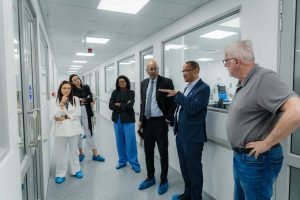The Ministry of Health, in collaboration with the Lamu County Government, today marked a significant step in Kenya’s journey toward Universal Health Coverage (UHC) with the official rollout of the Social Health Authority (SHA) and Digital Health Transformation in Lamu County.
The rollout coincided with the commissioning of transformative health infrastructure aimed at expanding critical and specialist care capacity across the region. These include a five-bed Intensive Care Unit (ICU) at the Lamu County Referral Hospital, offering critical care for both adults and children; private inpatient wards designed to enhance patient comfort and support hospital revenue generation; a PSA oxygen generating plant to supply medical-grade oxygen locally and reduce dependence on external supplies from Mombasa; a new 128-slice CT scan unit installed under the National Equipment Support Programme to boost radiological diagnostics; and a comprehensive Eye Care Unit at Mokowe Sub-County Hospital, equipped for surgical care and featuring an optical shop developed in partnership with the Kenya Society for the Blind.
Speaking during the event, Cabinet Secretary for Health, Aden Duale, EGH, commended Lamu for its progress, saying the initiative represents a national commitment to equitable and affordable care:
“No longer will Lamu residents be forced to travel to Kilifi or Mombasa for life-saving treatment. With these investments, we are saying that world-class care belongs here too. Combined with SHA and digital health tools, we are ensuring that quality care is not only close, but also consistent, affordable, and dependable.”
Lamu Governor Issa Timamy, welcomed the collaboration between the county and the national government.
“These developments represent a turning point for our county. We are no longer sending patients away for care we can now provide here at home. And with SHA and digital health systems in place, we are making that care affordable and accountable,” he said.
“This is what partnership for the people looks like.”
SHA enables residents to register and contribute through Lipa SHA Pole Pole, a flexible model allowing daily, weekly, or monthly payments without interest or penalties. Once registered, patients can seek care from contracted facilities without facing out-of-pocket expenses at the point of need.
Mercy Mwangangi, CEO of the Social Health Authority, said the progress in Lamu is particularly meaningful given the county’s unique geography and health profile.
“Lamu is responding to healthcare challenges with urgency and resolve. From the double burden of communicable and non-communicable diseases to the risk factors like drug abuse and poor nutrition, SHA ensures no one is left behind,” she said. “Today, we celebrate a community stepping forward, registering, contributing, and seeking care without fear of cost.”
To date, 69,656 individuals in Lamu have registered under SHA, with 22,196 having completed means testing.
The average contribution is Sh625. Over 13,800 hospital visits have been recorded and Sh198 million in claims approved so far.
Out of 78 health facilities across the county, 39 are now connected to the SHA portal and are actively transacting.
The rollout also saw the distribution of 324 tablets to frontline health workers across Lamu, enabling real-time registration, record-keeping, and better patient tracking.
Anthony Lenaiyara, Acting CEO of the Digital Health Authority, said the long-awaited digitization of health services in Lamu is now a reality.
“From Mokowe to Mpeketoni, Amu to Kiunga, our digital tools are enabling Lamu’s health workers to deliver services with speed, accuracy, and follow-through. This marks the beginning of a health system that works smarter and reaches further. Digitization makes referrals seamless, claims transparent, and care better coordinated.”
The Lamu launch builds on similar SHA and digital health milestones achieved in other counties and is part of a broader national agenda to deliver UHC through people-centred systems, public-private partnerships, and digital innovation.







More Stories
AERC Opens High-Level Summit to Shape Africa’s New Development Agenda
IFC Boosts Africa’s Vaccine Drive with Biovac Cholera Trial Launch
Air France–KLM Reports KSh181B Q3 Profit, Steady Africa Operations